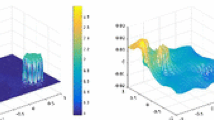Abstract
The employment of topological derivative concept is considered to propose a new optimization algorithm for the inverse conductivity problem. Since this inverse problem is nonlinear and ill-posed it is necessary to incorporate a prior knowledge about the unknown conductivity. In particular, we apply the Bayes theorem to add the assumption that we have just one small ball-shaped inclusion, which must be at a certain distance from the boundary of the domain. As the main emphasis of this paper is to investigate numerically the proposed approach, we shall use the meshless method of fundamental solutions to present some numerical results.





Similar content being viewed by others
References
Alves, C.J., Colaço, M.J., Leitão, V.M.A., Martins, N.F.M., Orlande, H.R.B., Roberty, N.C.: Recovering the source term in a linear diffusion problem by the method of fundamental solutions. Inverse Probl. Sci. Eng. 16, 1005–1021 (2005)
Ammari, H., Kang, H.: Reconstruction of Small Inhomogeneities from Boundary Measurements, 429 pages. Springer, Berlin (2004)
Amstutz, S., Andrä, H.: A new algorithm for topology optimization using a level-set method. J. Comput. Phys. 216(2), 573–588 (2006)
Berger, J.R., Karageorghis, A.: The method of fundamental solutions for heat conduction in layered materials. Int. J. Numer. Meth. Eng. 45, 1681–1694 (1999)
Bonnet, M.: Higher-order topological sensitivity for 2-D potential problems. Application to fast identification of inclusions. Int. J. Solids Struct. 46, 2275–2292 (2009)
Borcea, L.: Electrical impedance tomography. Inverse Probl. 18, R99–R136 (2002)
Ciulli, S., Pidcock, M.K., Sebu, C.: An integral equation method for the inverse conductivity problem. Phys. Lett. A 325, 253–267 (2004)
Comino, L., Gallego, R., Rus, G.: Combining topological sensitivity and genetic algorithms for identification inverse problems in anisotropic materials. Comput. Mech. 41, 231–242 (2007)
Eschenauer, H., Kobelev, V., Schumacher, A.: Bubble method for topology and shape optimization of structures. J. Struct. Optim. 8, 42–51 (1994)
Hansen, P.C.: Analysis of discrete ill-posed problems by means of the L-curve. SIAM Rev. 34, 561–580 (1992)
Hintermüller, M., Laurain, A.: Electrical impedance tomography: from topology to shape. Control Cybern. 37(4), 913–933 (2008)
Hintermüller, M., Laurain, A., Novotny, A.A.: Second-order topological expansion for electrical impedance tomography. Adv. Comput. Math. 36, 235–265 (2012)
Idier, J. (ed.): Bayesian Approach to Inverse Problems, 381 pp. ISTE, London (2008)
Isakov, V.: Inverse Problems for Partial Diferential Equations, 284 pp. Springer, New York (1998)
Isakov, V., Powell, J.: On inverse conductivity problem with one measurement. Inverse Probl. 6, 311–318 (1990)
Jin, B., Marin, L.: The method of fundamental solutions for inverse source problems associated with the steady-state heat conduction. Int. J. Numer. Meth. Eng. 69, 1570–1589 (2007)
Kaipio, J., Somersalo, E.: Statistical and Computational Inverse Problems, 339 pp. Springer, New York (2005)
Kang, H., Seo, J.K.: The layer potential technique for the inverse conductivity problem. Inverse Probl. 12, 267–278 (1996)
Karageorghis, A., Lesnic, D.: The method of fundamental solutions for the inverse conductivity problem. Inverse Probl. Sci. Eng. 18, 567–583 (2010)
Karageorghis, A., Lesnic, D., Marin, L.: A survey of applications of the MFS to inverse problems. Inverse Probl. Sci. Eng. 19, 309–336 (2011)
Knowles, I.: A variational algorithm for electrical impedance tomography. Inverse Probl. 14, 1513–1525 (1998)
Kohn, R.V., McKenney, A.: Numerical implementation of a variational method for electrical impedance tomography. Inverse Probl. 6, 389–414 (1990)
Kohn, R., Vogelius, M.: Relaxation of a varional method for impedance computed tomography. Comm. Pure Appl. Math. 40(6), 745–777 (1987)
Kozlov, V.A., Maz’ya, V.G., Movchan, A.B.: Asymptotic Analysis of Fields in Multi-Structures, 282 pp. Clarendon Press, Oxford (1999)
Kupradze, V.D., Aleksidze, M.A.: The method of functional equations for the approximate solution of certain boundary value problems. U.S.S.R. Comput. Math. Math. Phys. 4, 82–126 (1964)
Lesnic, D.: A numerical investigation of the inverse potential conductivity problem in a circular inclusion. Inverse Probl. Eng. 9, 1–17 (2001)
Marin, L., Elliott, L., Ingham, D.B., Lesnic, D.: The boundary element method for the numerical recovery of a circular inhomogeneity in an elliptic equation. Eng. Anal. Boundary Elem. 28, 413–419 (2004)
Novotny, A.A., Feijóo, R.A., Padra, C., Taroco, E.: Topological sensitivity analysis. Comput. Methods Appl. Mech. Eng. 192, 803–829 (2003)
Novotny, A.A., Sokołowski, J.: Topological Derivatives in Shape Optimization, 412 pp. Springer, Berlin (2012)
Ramachandran, P.A.: Method of fundamental solutions: singular value decomposition analysis. Commun. Numer. Methods Eng. 18, 789–801 (2002)
Rocha de Faria, J., Novotny, A.A., Feijóo, R.A., Taroco, E.: First- and second-order topological sensitivity analysis for inclusions. Inverse Probl. Sci. Eng. 17, 665–679 (2009)
Rocha de Faria, J., Novotny, A.A.: On the second order topological asymptotic expansion. Struct. Multi. Optim. 39(6), 547–555 (2009)
Sokołowski, J., Zochowski, A.: On the topological derivative in shape optimization. SIAM J. Control Optim. 37, 1251–1272 (1999)
Stuart, A.M.: Inverse problems: a Bayesian perspective. Acta Numerica 19, 451–559 (2010)
Wang, J., Zabaras, N.: Hierarchical Bayesian models for inverse problems in heat conduction. Inverse Probl. 21, 185–206 (2005)
Acknowledgments
The first author would like to thank CNPq-Science without Borders program for the financial support in this research. The hospitality shown by the University of Leeds is also gratefully acknowledged. The comments made by the referee are gratefully acknowledged.
Author information
Authors and Affiliations
Corresponding author
Rights and permissions
About this article
Cite this article
de Faria, J.R., Lesnic, D. Topological Derivative for the Inverse Conductivity Problem: A Bayesian Approach. J Sci Comput 63, 256–278 (2015). https://doi.org/10.1007/s10915-014-9891-4
Received:
Revised:
Accepted:
Published:
Issue Date:
DOI: https://doi.org/10.1007/s10915-014-9891-4



